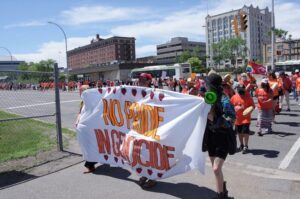No Pride in Genocide marchers call on protectors and allies to come together

By Rick Garrick
THUNDER BAY — Biinjitiwaabik Zaaging Anishinaabek Elders Diane Hardy and Jim Misquart emphasized the impacts of Indian Residential Schools at the July 1 No Pride in Genocide march in Thunder Bay.
“What has taken place over the course of centuries to our people is still affecting us today and one of the messages the old people talk about is that we need to concentrate on our children,” Misquart says. “All the teachings, the stories, the hard times and the good times that we have endured, those are our main focus for the future, and that’s why I’m glad that everyone is here to support this.”
Misquart sang a Flag Song during the gathering after the walkers completed the march from Waverley Park to the Thunder Bay waterfront.
“That [song] was paying tribute to all of our Indigenous communities right across Canada,” Misquart says. “It was acknowledging all of our communities, and that was a song for everyone across Canada.”
Hardy brought a three-year-old-sized shirt to the march to demonstrate the age of some of the 215 children discovered at the former Kamloops Indian Residential School site in B.C.
“I’ve been in contact with these residential school [survivors] ever since Gord Downie had that commentary on TV about the little [Chanie] Wenjack boy that left residential school to walk home and froze to death,” Hardy says. “Many years ago, I was up in Fort Albany and I saw the [St. Anne’s Indian Residential] School and they were talking about the kids. It was heartbreaking, it was an awful time for us.”
Hardy says it was important to participate in the march even though she could not walk with her walker.
“I’m walking and united with my people here — I think of my mom and I think of all the others, what they’re going through across Canada,” Hardy says. “It went very well even though I couldn’t walk that far. I’m glad it was a nice day for everybody to gather together here. I will never celebrate Canada Day again after seeing this.”
A group of youth organized the march, which began at 2:15 pm in honour of the 215 children discovered at the former Kamloops Indian Residential School.
“The corporation of Canada was built on the oppression, displacement and land theft of Indigenous peoples so it’s really hard for me to see people celebrating that,” says Cynthia Nault, one of the organizers of the march and a Red Rock Indian Band citizen. “It’s really hard to see people having picnics and fireworks, especially when so many people are grieving right now with all of the recent recoveries that are happening right now across Turtle Island.”
Nault says there was a larger turnout than expected at the march, noting that it was important for people to attend the march and do some listening and learning.
“I think Canada as a nation and Canadians have to do some serious work and decide going forward how they want to live with First Nations people,” Nault says. “First Nations people have been here longer than Canada and our relationship between peoples used to be a lot better as was shown by the Two Row Wampum Belt, so I’d like to see us getting back to that type of relationship where we live together.”
Nault says a group of people helped prepare for the march and to make signs for the walkers.
“Shelby Gagnon was quite a big help in the art for the two sign-making days we had in advance of the event,” Nault says.


